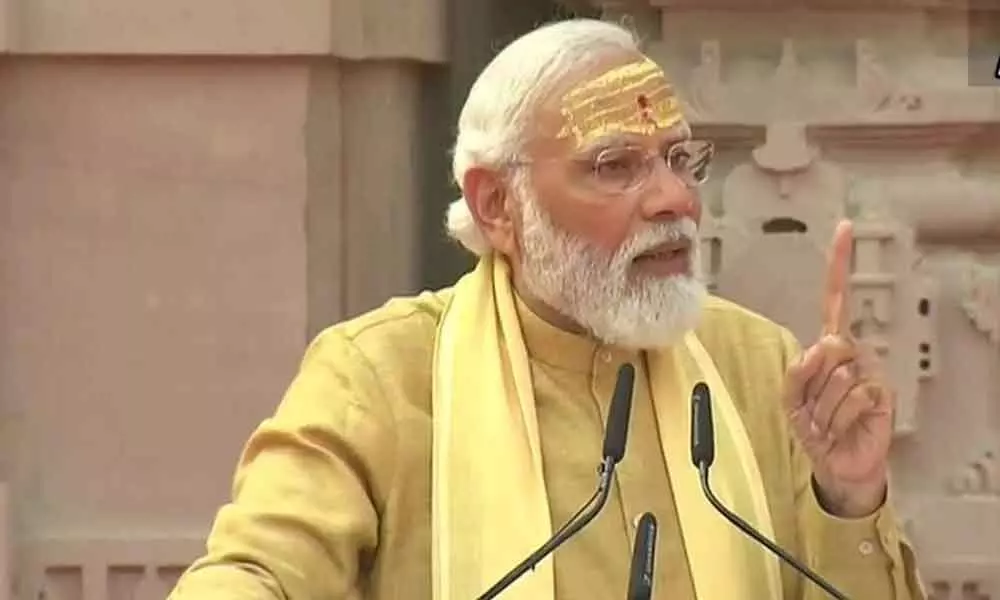Where's the spirit of Indian Constitution in PM's deeds?
The Prime Minister has time and again reaffirmed his religious preference.
image for illustrative purpose

The Prime Minister has time and again reaffirmed his religious preference. The inauguration of the Kashi Vishwanath Corridor is the latest example. His pujas and participation in Ganga Aarati were all choreographed to project him as a Hindu leader. Is this not a violation of the spirit of the Constitution of India? If the construction of the corridor displays the religious preference of the present state, it also signifies an onslaught of Hindutva on the core of Hinduism.
India has undergone a major change under Modi's rule. The polity has lost its secular character. Though the Constitution mandates a strict adherence to secularism, the state is increasingly turning away from it. Minorities are losing their political and social space. The Citizenship Amendment Act is a glaring example of it. A long, peaceful agitation at Shaheen Bagh could not yield any result.
This is not the first time the people at the top of the executive have been found wanting in their adherence to the secular behaviour mandated by the constitution. They have often demonstrated their sympathy towards the religion of the majority community. Though such demonstrations did impede the prospect of neutrality towards different religious faiths, they were different from an open display of religious preferences.
Earlier, the expression of religious preferences was covert and people tried to balance it by showing their reverence for other faiths. We do not know of any prime minister who was part of a religious trust or who was involved in the inauguration of a temple. Prime Minister Modi does not stop at laying the foundation stones of temples or inaugurating them; he defines his acts in political terms. He does all these in his official capacity and in his capacity as a leader of a political party, the Bhartiya Janata Party. Both these acts are against the spirit of the constitution. No one of his predecessors has acted in this manner. He chooses these events to promote his politics of Hindutva.
In this case too, the Prime Minister did everything to politicise the event and tried to identify it with the state. The Prime Minister's Office issued press releases to inform the nation of the event and took care of highlighting the fact that it was an outcome of the Prime Minister's vision. The presence of Governor Anandiben Patel, chief minister Yogi Adityanath and their ministerial colleagues ensured the official character of the event, and the participation of BJP president JP Nadda emphasized its political character.
However, a deep insight into the "vision of the prime minister" reveals an invisible intent no less important. People may look at the destruction of cultural artifacts in Varanasi as an act of negligence. This understanding ignores the ultimate goal of the Hindutva project. The real ambition is to redefine Hinduism and make it monolithic. The Hindu religion carries diverse beliefs that, at times, are opposed to each other. It allows mutually antagonistic ideas to survive side by side. Political Hinduism, or Hindutva, is opposed to this character of their religion. It tries to create hegemony. It tries to destroy the ideas that go against the attempt at regimentation of religion. Varanasi's Ghats and city have presented an amalgamation of different paths of spiritualism enshrined in Hinduism. The structures that have been built over several centuries express this amalgamation.
Varanasi is one of the very few ancient cities that have been uninterruptedly inhabited by humans. The excavations reveal its antiquity that goes back to 1200 BCE. According to historians, the city was originally a trading center. It owes its emergence as a trading center to the changing course of the Ganges. Here, the Ganges abruptly turns northwards. The ancient northern trade route crosses the river at this location. The southern trade route is also linked to the location. Both of them made it an important trade center. However, during and after the Gupta period, 600 C.E. and onwards, the city started turning into a pilgrimage center, and it found an important place in the narratives of the Puranas as a holy city. By 900 CE and 1000 CE, the city was one of the holiest places for Indians. The place was already an important pilgrimage center for Buddhists and Jains. The Sarnath stupa testifies to the importance of the city as a Buddhist pilgrimage center. Jain texts claim the city as the birthplace of many of its Tirthankars.
The development of the city as the holy city of Hindus during medieval and modern times not only involved the symbiotic existence of different sects and traditions in spiritual space and religious rituals but also exhibited diversity in its structures and artifacts. Here, we find a blending of Shaivism and Vaishnavism. Most of the important Bhakti poets, such as Tulsidas, Kabirdas, and Raidas, were associated with the place where Shiva is the presiding deity. Sikhism does have its own share in the glory of the city. Guru Nanak Dev had visited the place. The artifacts of the city also display different traditions associated with the Mughals, Marathas, and rulers of Bengal, Avadh, and Southern kingdoms.
The new architecture is posing a grave danger to the composition of the city. This aspect of the Hindutva project in Varanasi should not be overlooked.
(Anil Sinha is a senior journalist. He has experience of working with leading newspapers and electronic media including Deccan Herald, Sunday Guardian, Navbharat Times and Dainik Bhaskar. He writes on politics, society, environment and economy)

